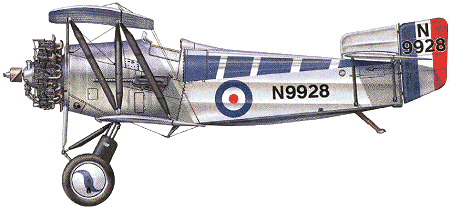 |
Fairey Flycatcher1922 |  |
| FIGHTER | Virtual Aircraft Museum / United Kingdom / Fairey |
 |
Built to Air Ministry Specification 6/22, the prototype of what became named the Fairey Flycatcher made its first flight during 1922. A single-seat fighter for first-line service aboard aircraft carriers, it could have interchangeable wheeled, float, or combined wheel/float amphibious landing gear. In this latter form, the ground-contact tread of each wheel was only inches below the undersurface of the float, causing many raised eyebrows as, apparently, a floatplane was to be seen taking off from a grass airfield. Construction was composite with wooden fabric-covered wings and a fuselage of wood and metal with fabric covering. Some of the nicest people are eccentrics: the Flycatcher seemed to belong in this category, following what appeared to be normal Fairey practice of sacrificing good looks for good performance. The result was an aeroplane which only its designer, or its pilot, could love. Single-bay biplane wings, well-staggered, with pronounced dihedral on the upper wing and a fuselage which appeared to curve upwards to the tail unit, gave the impression that a giant had used this little fighter as a seat. When seen in profile in flight it looked distinctly odd. But these quirks of configuration (plus Fairey's Patent Camber Gear) provided an aeroplane that was easy to fly, even at low speeds, and yet one which was highly manoeuvrable. No wonder that pilots were enthusiastic about it. Flycatchers remained in service from 1923 until declared obsolete in 1935, during which period 192 were built. Like their contemporary Fairey IIIF, they had the distinction of serving on board all British aircraft carriers of that period. In addition, harking back to World War I procedure, they operated as landplane fighters from a short take-off platform mounted above the gun turrets of capital ships. Their trailing-edge flaps and drooped ailerons provided a steep path of descent which was ideal for carrier landing. One Flycatcher was fitted experimentally with hydraulic brakes which permitted a very short landing run. This was the first FAA aircraft to have such brakes, but they did not then become standard equipment. Once on deck, they did not have the benefit of folding wings to simplify shipboard stowage. Instead they were designed to be dismantled easily into sections which did not exceed 4.11m in length. The training, skill and enthusiasm of deck handling crews made possible such feats as a record of six aircraft landed and stowed in their hangars in only 4 minutes 20 seconds. Landing, of course, was carried out on the main deck. But these little fighters (housed in a forward hangar) could take off from a special tapered runway, only 18.3m in length, leading directly from their hangar and out over the bows. Undoubtedly the Flycatcher made an important contribution to the best traditions and practice of naval flying.

|  COMPANY PROFILE | |||||||||||||||||||||||||||||||||||||||||||||||||||||||||
 |

|

